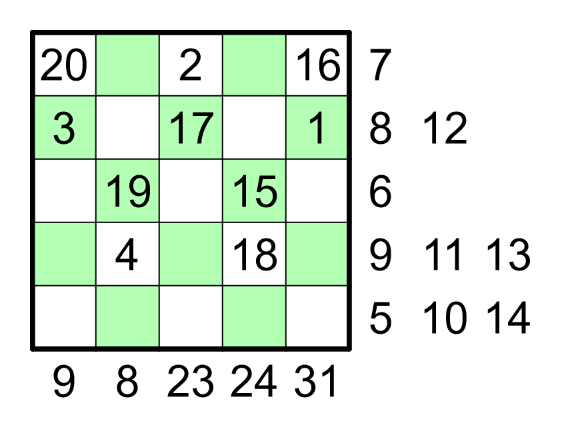It isn't necessary to have all the column sums for a unique solution. You only need the third or fifth, plus the parity of the second or fourth.
20 .. .. .. .. | 2 2 2 2 2 X2 X2 X5 7
.. .. .. .. 01 | 2 2 2 2 2 3 3 17
.. .. .. .. .. | 2 3 3 5 19
.. .. .. .. .. | 2 2 2 3 3 3 3 11 13
.. .. .. .. .. | 2 2 5 5 7
Product rules put the 17 on second row, 19 and 15 on third, 11 and 13 on fourth. The only way to put the 19 on third and be a knight's move from the 20 is R3C2.
20 .. .. .. .. | 2 2 2 2 2 7
.. .. .. .. 01 | 2 2 2 2 2 3 3 : 17
.. 19 .. .. .. | 2 3 : 15
.. .. .. .. .. | 2 2 2 3 3 3 3 : 11 13
.. .. .. .. .. | 2 2 5 5 7
The 18 can't be on row 1 or 5 because those rows aren't divisible by 3. It can't be on rows 2 or 3 because those rows can't be a knight's move from the 17 or 19, respectively. The only place on row 4 that's a knight's move from 19 is R4C4. The only place on row 2 that's a knight's move from R4C4 that isn't already occupied is R2C3.
20 .. .. .. .. | 2 2 2 2 2 7
.. .. 17 .. 01 | 2 2 2 2 2 3 3 :
.. 19 .. .. .. | 2 3 : 15
.. .. .. 18 .. | 2 2 3 3 : 11 13
.. .. .. .. .. | 2 2 5 5 7
The only place that's a knight's move from 17 and is on a row divisible by 16 in R1C5. The only unused place that's a knight's move from 16 is R3C4.
20 .. .. .. 16 | 2 7
.. .. 17 .. 01 | 2 2 2 2 2 3 3 :
.. 19 .. 15 .. | 2 3 :
.. .. .. 18 .. | 2 2 3 3 : 11 13
.. .. .. .. .. | 2 2 5 5 7
14 can't go on row 1 (it's not a knight's move from 13), so it's on the other line divisible by 14 (row 5). 2 and 3 can't go on the same row, so row 3 must use 6. 5 and 10 can only go on row 5 (only row divisible by them). 14 isn't on row 1, so it must hold 2 and 7.
20 .. .. .. 16 | : 2 7
.. .. 17 .. 01 | 2 2 2 2 2 3 3 :
.. 19 .. 15 .. | : 6
.. .. .. 18 .. | 2 2 3 3 : 11 13
.. .. .. .. .. | : 5 10 14
3 can only go on row 2 (row 4 isn't a KM from the 2 on row 1). 4 must go on row 4. 8 goes on row 2 (only row divisible). 9 goes on row 4 (only row divisible). 12 goes on row 2 (only row divisible)
20 .. .. .. 16 | : 2 7
.. .. 17 .. 01 | : 3 8 12
.. 19 .. 15 .. | : 6
.. .. .. 18 .. | : 4 9 11 13
.. .. .. .. .. | : 5 10 14
KM and row constraints force positions of 2 through 5. The only way to place the 10 a KM from two different cells on row 4 is in R5C3; 9 and 11 are in R4C1 and R4C5 in some order, forcing R4C3 as 13. 14 must now go in R5C5.
20 .. 02 .. 16 | : 7
03 .. 17 .. 01 | : 8 12
.. 19 .. 15 .. | : 6
.. 04 13 18 .. | : 9 11
__ __ 10 05 14 | :
And that's what you can get while ignoring the column constraints.
The unknown cells in R4 are odd; the unknown cells in R2, R3, and R5 are even or empty. If the 7 is in R1C2, then all columns will have even sum. If the 7 is in R1C4, then C1, C3, and C5 have even sum and C2 and C4 have odd sum. Since we were given they were odd, that forces 7 to R1C4, and KMs force 8-12:
20 __ 02 07 16 | :
03 08 17 12 01 | :
.. 19 .. 15 .. | : 6
09 04 13 18 11 | :
__ __ 10 05 14 | :
Finally, the sum of C3 or C5 gives the position of the 6.
20 __ 02 07 16 | :
03 08 17 12 01 | :
__ 19 __ 15 06 | :
09 04 13 18 11 | :
__ __ 10 05 14 | :
Looking back, the sum of C5 is enough to solve the puzzle.
Alternately, if instead of the column sums, we were just given that C2 or C4 had an even sum, that would be enough to force the whole grid.







